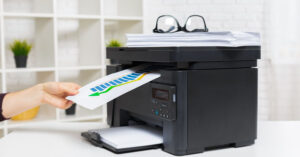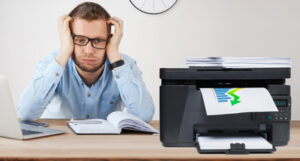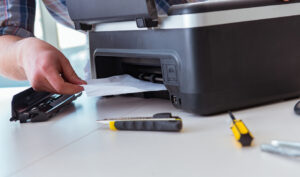Is your printer acting up again? Few tech issues are as frustrating as a printer not printing. Whether you’re facing a printer that refuses to cooperate, a device that’s producing blank pages, or color printing problems, this post will walk you through all the common causes and practical solutions to get your printer back in working order.
Common Reasons Why Your Printer Is Not Printing

When your printer stops printing, several factors could be at play. Understanding them will help you diagnose and fix the issues.
1. Physical Connection Issues
One of the most frequent causes of printer not printing is connection failures. If your printer appears offline or unresponsive, check the physical connections first. Ensure that all cables are securely plugged in and undamaged. For wireless printers, verify that the device is properly connected to your network.
Whenever you face trouble connecting to your printer make sure that it is turned on. Then, you should check all the cables connected to it for signs of damage, and ensure they are firmly plugged in.
For wired connections, inspect USB or Ethernet cables for visible damage. Frayed or pinched cables might work intermittently or not at all. If you suspect cable damage, replace it with a new one to see if that resolves the issue.
2. Paper and Supply Problems
Paper jams and improper paper loading can prevent your printer from functioning correctly. Make sure paper is properly loaded in the tray and check for any obstructions in the paper path.
When clearing paper jams, be thorough: Don’t leave any little bits of paper behind if you are fixing a jam. Even small fragments can cause persistent problems.
3. Ink or Toner Issues
Low or empty ink cartridges are a leading cause of printer not printing in color. Most modern printers will alert you when ink levels are low, but these systems aren’t always accurate.
For inkjet printers, clogged print heads are a common culprit, especially if the printer hasn’t been used for an extended period. When ink dries in the nozzles, it can block the flow of new ink, resulting in spotty prints or completely blank pages.
Clogged print heads are an outcome of the ink nozzles getting blocked with dried up ink. It causes patchy printing or blank pages. This can often happen when the printer isn’t used or maintained regularly.
Troubleshooting Steps for Printers Not Printing

Printers of all brands can experience specific issues that prevent proper printing. Here’s how you should address common problems with HP printers.
1. Check Basic Connections and Power
Before getting into complex solutions, verify that your printer is:
- Plugged in and powered on
- Connected to your computer or network
- Loaded with paper
- Free of paper jams
- Equipped with sufficient ink or toner
A simple power cycle can resolve many temporary glitches: “Turn off your printer and computer and wait at least 30 seconds before turning them back on. After that, test the printer connection after both have fully booted back up, to see if your printer is back online.
2. Clear the Print Queue
Previous print jobs can sometimes get stuck in the queue, preventing new documents from printing. To fix this:
- Click on the printer icon on your taskbar
- Open the printer queue window
- Select all pending print jobs
- Delete them
- Make sure “Pause Printing” and “Use Printer Offline” options are unchecked
3. Update or Reinstall Printer Drivers
Outdated or corrupted printer drivers can cause communication issues between your computer and printer. Visit the official website to find and download the latest drivers for your specific printer model.
If the printer driver is not updated or doesn’t work with the printer, the printer won’t print.
Why Is My Printer Not Printing Anything?

If your printer goes through the motions of printing but produces completely blank pages, several factors might be responsible.
1. Empty or Defective Cartridges
The most obvious culprit for blank pages is empty ink or toner cartridges. Check your printer’s ink levels. Replace any depleted cartridges.
You can test cartridges by blotting them on a damp tissue. A cartridge that is of high-quality leaves a dark blot of shades. These include cyan, magenta and yellow or black.
2. Printing Head Issues
For inkjet printers, dried-out print heads can prevent ink from transferring to the paper. Most printers have built-in cleaning utilities that can help resolve this issue.
Some printers have can enable the machine to check the print head nozzles, so you don’t need to do much. If you need to manually check, use warm water and a soft cloth to remove ink and then carefully reattach it to your printer.
If cleaning cycles don’t work, soaking the printhead in about 1 of very hot water for 10 minutes or so may clear the nozzles.
3. Software and Setting Problems
- Incorrect print settings can sometimes result in blank outputs. Verify that:
- The correct paper size is selected
- Print quality settings are appropriate
- You’re not accidentally printing blank pages from your document.
- Always check the printer settings twice before clicking print.
Printer Not Printing in Color: Why and How to Fix

Color printing problems are particularly frustrating when you need vibrant documents or photos. Here’s why your printer might not be printing in color and how to address it.
1. Color Ink Depletion
The most common reason for color printing failures is depleted color cartridges. Even if you primarily print in black and white, color cartridges can dry out over time.
2. Print Settings Set to Grayscale
Sometimes, the simplest explanation is that your printer is set to grayscale or black and white mode. Check your print settings before sending documents to ensure color printing is enabled.
3. Clogged Color Nozzles
Like black ink nozzles, color ink nozzles can become clogged with dried ink. Running cleaning cycles can help resolve this issue. Clean the color ink cartridge up to 2 times. Then, test page to check the output
4. Print Head Alignment Issues
Misaligned print heads can cause color printing problems. Most printers have an alignment utility that prints a test page and adjusts the print heads accordingly.
5. Dealing with Printer Spooler Errors
The print spooler is a crucial service that manages print jobs. When it encounters problems, your printer may stop responding entirely.
To rectify a spooler issue, try these steps:
- Press the Windows key and type “services”
- Open the Services app
- Find “Printer spooler” in the list
- Right-click and select “Stop”
- Wait 30-60 seconds
- Right-click “Printer spooler” again and select “Start”
This process clears any stuck print jobs and refreshes the spooler service and fixes printing problems.
6. Troubleshooting Network Printer Issues
Network printers add another layer of complexity to troubleshooting. If your network printer appears offline, try these solutions.
7. Verify Network Connectivity
Ensure your printer is connected to the network that your computer uses. For wireless printers, check that they’re connected to the correct Wi-Fi network, especially if you’ve recently changed your network settings or password.
8. Check Printer Status on the Network
Access your router’s administration page to verify that the printer is connected and has a valid IP address. Some printers have a network test function that can identify connectivity issues.
9. Restart Network Equipment
Sometimes the issue might be with your network and not with the printer you own. Try restarting your router and modem to refresh network connections.
Preventive Tips to Avoid Printing Problems
Regular maintenance prevents common printing issues before they occur.
1. Regular Cleaning
Keep your printer clean. Remove dust and debris regularly. Pay special attention to paper feed rollers. Clean the printer rollers via lint-free cloth. Remember to rotate them to clean the entire surface.
2. Proper Usage Habits
- Develop good habits to extend your printer’s life:
- Allow cartridges to park properly before turning off the printer
- Use the printer regularly so ink is prevented from drying out
- Use high-quality paper compatible with your printer type
- Keep the printer in a clean environment
3. Regular Software Updates
Keep printer drivers and firmware updated to ensure compatibility with your operating system and to benefit from performance improvements
When to Seek Professional Help
While many printer issues can be resolved at home, some problems require professional intervention. Consider contacting technical support if:
- You’ve tried all troubleshooting steps without success
- The printer shows error codes not covered in the manual
- You notice unusual noises or smells during operation
- There are signs of electronic failure
Conclusion
With this troubleshooting guide, you’re well-equipped to diagnose and resolve most common printer issues. From checking basic connections to addressing complex spooler errors, they’ll get your printer back running and producing the documents you need.
Remember that regular maintenance is key to preventing future problems. By keeping your printer clean, updating software regularly, and using quality supplies, you can significantly reduce printing issues, no matter the brand. If all else fails, don’t hesitate to contact the manufacturer’s support team or a qualified technician who can provide specialized assistance for your specific printer model.